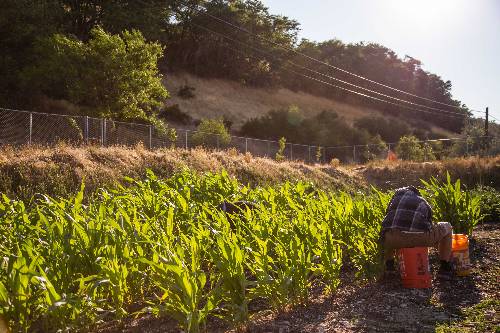The Advantages of Regenerative Agriculture for Dirt Wellness
The Advantages of Regenerative Agriculture for Dirt Wellness
Blog Article
Enhance Agricultural Productivity With High-Quality Water Soluble Polymers
These polymers offer a variety of advantages that can change standard farming techniques, from boosting water retention and effectiveness to enhancing soil framework and nutrient distribution systems. By utilizing the power of cutting-edge polymer options, farmers can possibly unlock brand-new pathways in the direction of accomplishing higher crop returns while alleviating environmental effects.

Advantages of Water-Soluble Polymers
Water-soluble polymers provide a wide variety of advantages in agricultural applications because of their boosted water retention residential properties and ability to boost soil framework. Agriculture. These polymers, when added to the soil, can dramatically raise water holding capability, minimizing the frequency of watering needed by crops. By developing a gel-like substance when blended with water, water-soluble polymers create a storage tank that slowly releases wetness to plant roots, guaranteeing a more consistent water during dry spells
In addition, these polymers aid in preventing soil disintegration by binding soil particles with each other, thereby improving soil structure and stability. Enhanced dirt framework enables better root penetration and aeration, promoting much healthier plant development and greater crop returns. Water-soluble polymers also help in nutrient retention by decreasing leaching, guaranteeing that necessary nutrients stay readily available to plants for a longer period.
Improved Water Retention and Efficiency
Enhancing farming water retention and efficiency with the incorporation of innovative polymer technologies has come to be a vital emphasis in modern farming methods. Water-soluble polymers play an essential duty in improving dirt framework, enhancing water seepage, and reducing water evaporation rates. By forming a slim film on the soil surface area, these polymers help to prevent water overflow and enhance the soil's water-holding capacity, making certain that plants have access to an appropriate supply of water.
In addition, using top quality water-soluble polymers can substantially lower the frequency of watering, as they boost the dirt's ability to keep moisture for longer periods. This not just conserves water however additionally reduces the energy and labor expenses connected with watering techniques. Furthermore, enhanced water retention and efficiency result in much better nutrient uptake by plants, resulting in enhanced plant returns and total agricultural performance.
Improved Nutrient Shipment Solution
Given the significant influence of high-grade water-soluble polymers on enhancing water retention and efficiency in agriculture, the emphasis now shifts towards enhancing nutrient distribution systems to further boost plant development and yield. Boosted nutrient distribution systems play a crucial function in making sure that plants get the needed nutrients in a type that is easily offered for uptake, advertising their total health and wellness and performance. By integrating water-soluble polymers into nutrient shipment systems, the efficiency of nutrient uptake by plants can be considerably boosted.
One trick benefit of using top notch water-soluble polymers in nutrient shipment systems is their capacity to regulate the release of nutrients, making sure a regulated and consistent supply to plants over an extended duration (Agriculture). This controlled release device helps avoid nutrient leaching and drainage, thus taking full advantage of nutrient application by crops and reducing ecological impact

Dirt Framework Optimization Strategies
Optimizing soil structure is extremely important in modern agriculture for making the most of crop returns and promoting sustainable land management practices. Dirt structure optimization techniques play a critical role in guaranteeing that dirt provides a suitable atmosphere for plant development. One crucial method is the enhancement of raw material, such as compost or manure, which helps enhance soil framework by enhancing its water-holding capability and nutrient retention.
Additionally, practicing minimal tillage or no-till farming can avoid dirt compaction and advertise the development of a healthy dirt structure. Cover cropping is one more reliable technique that involves growing plants especially to enhance the soil and secure, protecting against erosion look at here and boosting soil structure.
Additionally, executing plant turning approaches can assist damage parasite and disease cycles, while also enhancing dirt framework via the varying origin structures of different crops. In general, utilizing these dirt structure optimization strategies can bring about raised farming performance, reduced ecological influence, and long-term sustainability in farming techniques.
Sustainable Solutions for Plant Returns

To attend to the difficulties of making best use of crop yields while advertising lasting land management methods, discovering lasting services comes to be crucial in modern farming. One lasting option for improving crop returns is the use of accuracy farming methods.
Moreover, advertising crop rotation and cover chopping can assist keep soil wellness, decrease disintegration, and improve nutrition cycling, inevitably adding to higher yields with time. Integrated pest administration strategies likewise play a vital function in sustainable plant manufacturing by lessening the reliance on chemical pesticides and promoting natural insect control approaches.
Furthermore, purchasing study and development for developing drought-resistant crop selections and climate-resilient farming methods can help Continued minimize the impact of climate change on agriculture while making certain constant yields when faced with ecological obstacles. By embracing these sustainable services, farmers can attain higher crop yields while safeguarding the wellness of the land for future generations.
Verdict
In conclusion, the use of high-quality water-soluble polymers in farming supplies various advantages such as enhanced water retention, improved nutrient delivery systems, and maximized dirt structure. By applying lasting solutions for plant yields, farmers can considerably enhance farming performance and performance. Agriculture. Water-soluble polymers give a cost-effective and eco-friendly technique to improve the overall efficiency of farming techniques, bring about better results for both farmers and the atmosphere
These polymers use an array of advantages that can change standard farming techniques, from enhancing water retention and performance to optimizing dirt framework and nutrient distribution systems.In addition, these polymers aid in avoiding dirt disintegration by binding soil fragments together, therefore improving soil framework and stability. By developing a slim film on the dirt surface area, these polymers aid to stop water runoff and boost the dirt's water-holding ability, making sure that plants have access to an ample water supply.
Soil framework optimization methods play an essential function in guaranteeing that soil provides an ideal setting for plant growth.In verdict, the use of high-quality water-soluble polymers in read this post here agriculture offers many benefits such as improved water retention, enhanced nutrient distribution systems, and maximized dirt framework.
Report this page